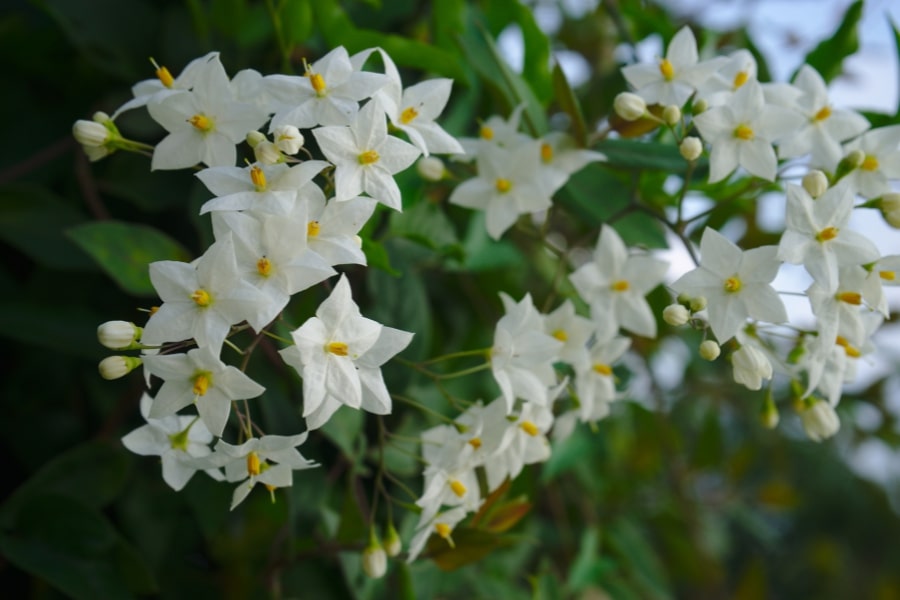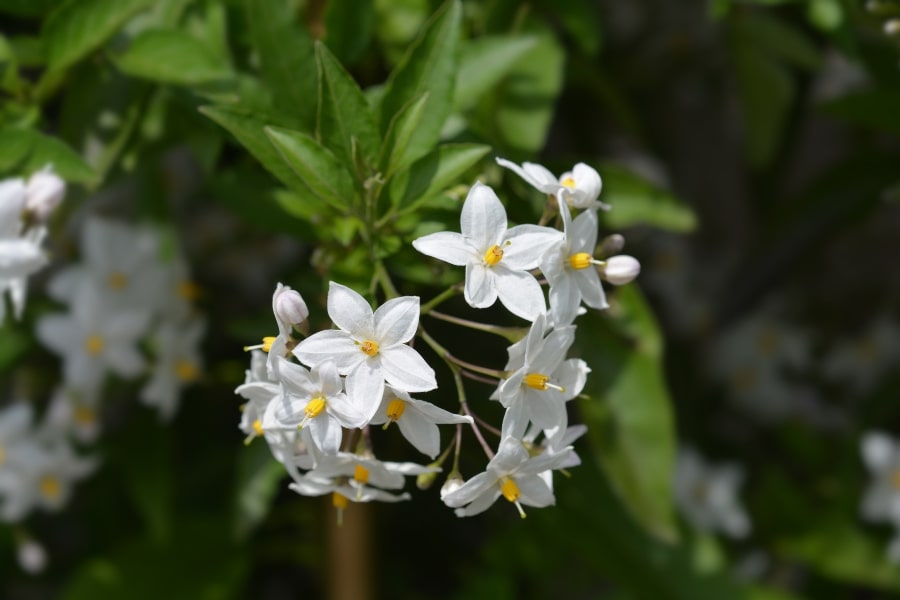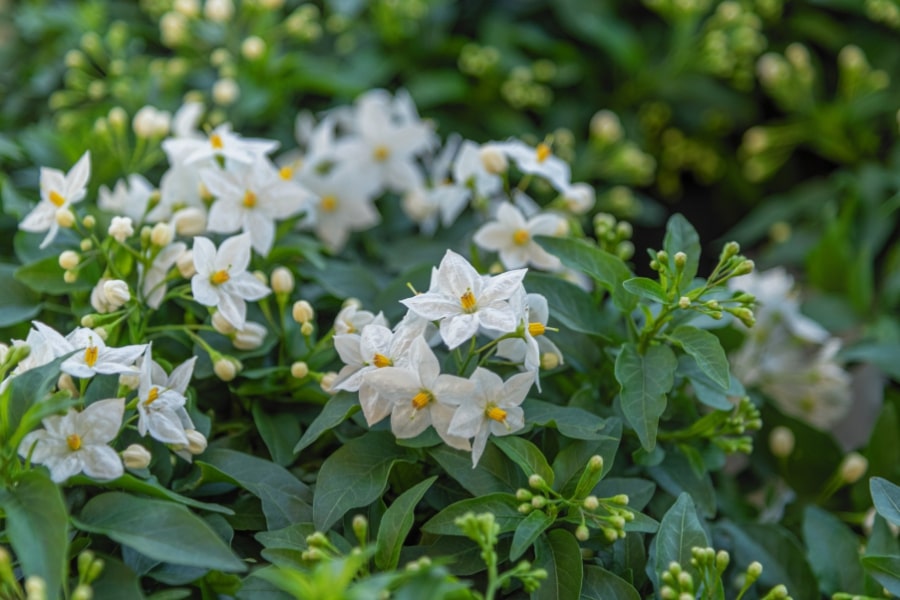Despite its name, the Potato Vine is not related to potatoes; instead it belongs to the Solanaceae family, which includes tomatoes, peppers, and eggplants. Native to South America, particularly Brazil and Argentina, the Potato Vine has become popular worldwide as a garden and landscaping plant, valued for its cascading vines and clusters of delicate flowers. This is NOT the Sweet Potato Vine (Ipomoea). It is the Potato Vine, an annual vine which will bloom from spring to first frost.

Our Selection Of Potato Vine
It’s hard to decide which name to use when describing which Potato Vine is sold at Martin Garden Center, so we decided to go with Potato Vine even though calling it the Yellow Zebra Potato Vine (the Proven Winners name for it) would have power, even if they only qualify as Proven Selections.
We grow 4″ containers and 10″ hanging baskets of Potato Vine throughout the season, but we don’t consistently have them in stock because they are hard to root, and because there is limited demand for them. Consequently, if you see it, buy it because it may be a while until we have it again.
Growing and Caring For Potato Vine
- Sunlight and Location: Potato vine thrives in part sun to full shade, so don’t even try to add it to a full sun pot. When selecting a planting location, choose an area that receives filtered sunlight for optimal growth and flowering. If growing potato vine indoors, place it near a sunny window where it can receive indirect sunlight throughout the day.
- Soil and Watering: Potato vines prefer well-draining soil that is rich in organic matter. Before planting, amend the soil with compost or aged manure to improve its fertility and drainage. Water the plants regularly, keeping the soil evenly moist but not waterlogged. Allow the top inch of soil to dry out slightly between waterings, especially during hot, dry weather. Mulching around the base of the plant can help retain moisture and suppress weeds.
- Support and Pruning: Potato vine is a climbing vine that requires support to grow upward. Provide a sturdy trellis, arbor, or other support structure for the plant to climb on. As the vine grows, gently train it to climb along the support structure using soft ties or twine. Regular pruning is also essential for maintaining the plant’s shape and promoting bushy growth. Prune back any leggy or straggling stems and dead or diseased growth to encourage new growth and flowering.
- Fertilizing: Fertilize potato vine regularly throughout the growing season to promote healthy growth and flowering. Use a balanced, water-soluble fertilizer formulated for flowering vines, following the manufacturer’s instructions for application rates and frequency. Avoid over-fertilizing, as excessive fertilizer can cause salt buildup in the soil and lead to nutrient imbalances.
- Overwintering and Protection: In cooler climates, potato vine may be treated as an annual or overwintered indoors to protect it from frost and freezing temperatures. Before the first frost, bring container-grown plants indoors to a cool, bright location, such as a greenhouse or sunny window. Alternatively, take stem cuttings from outdoor plants to propagate new plants for the following growing season.
- Common Pests: Aphids like this plant so be prepared to treat it with Bonide Insecticidal Soap if Aphids are present. They gravitate to the new growth and the flowers, so you will find them there. If Aphids are found, treat 2 times, once a week apart, to eradicate the infestation.
Leaves and Flowers
The foliage of the Potato Vine is dense and lush, providing a verdant backdrop for its abundant clusters of flowers. The leaves are small, oval-shaped, and bright green, with a slightly hairy texture. While the foliage is attractive in its own right, the plant’s profusion of flowers steals the show.
The flowers of the Potato Vine are small, trumpet-shaped, and typically white or pale lavender, although some cultivars may produce flowers in shades of pink or purple. The flowers are borne in clusters at the tips of the vines and bloom continuously from late spring to fall, attracting pollinators such as bees and butterflies to the garden.

Uses In The Garden
Potato Vines are incredibly versatile and can be used in various ways to enhance garden landscapes and outdoor spaces. Their vigorous growth habit and cascading vines make them ideal for covering trellises, arbors, pergolas, or fences, providing vertical interest and a burst of color throughout the growing season. They can also be trained to climb up walls or scramble over rocks and boulders, adding a touch of natural beauty to hardscaped areas.
In addition to their use as climbers, Potato Vines are well-suited in hanging baskets, containers, or window boxes, which spill over the edges and create a cascading effect. Pair them with complementary flowering plants or trailing foliage plants to create stunning mixed containers that brighten patios, balconies, or outdoor seating areas. Potato Vines also make excellent ground covers, where they can be used to fill in bare spots or provide erosion control on slopes or hillsides.

Frequently Asked Questions
Is Potato Vine Annual or Perennial?
It is not a perennial or evergreen here in the Upstate, despite the claims in some of the written information on the world wide web. Instead, it is an annual, period!
Is The Potato Vine Invasive?
While Potato Vines can be vigorous growers, they are not typically considered invasive in most regions. However, they may spread quickly if not properly maintained or contained, so it’s essential to monitor their growth and prune them regularly to keep them in check.
Is The Potato Vine Toxic To Pets?
Yes, Potato Vine is toxic to pets if ingested, particularly the berries. Keep pets away from Potato Vine plants and promptly remove any fallen berries from the ground to prevent accidental ingestion.
